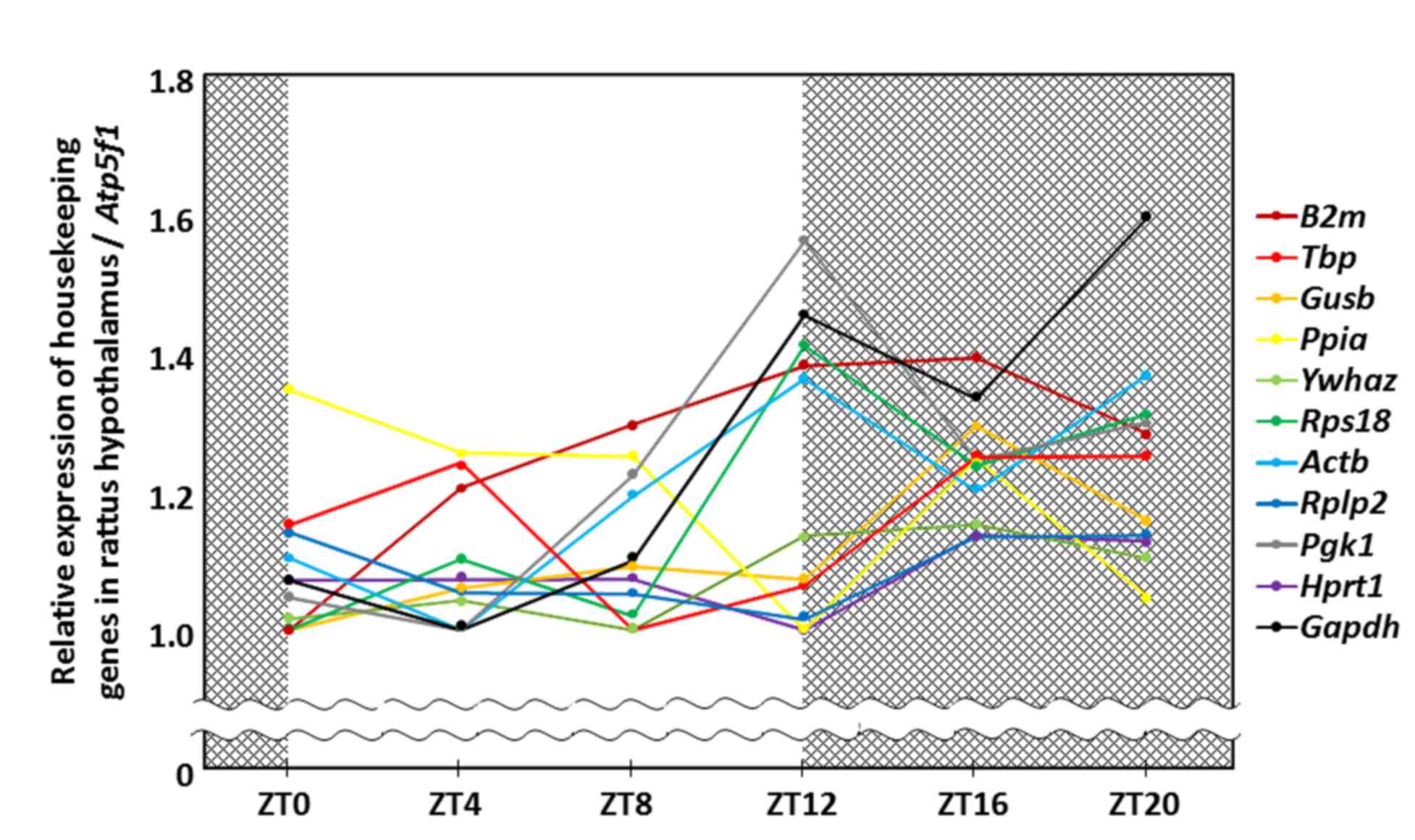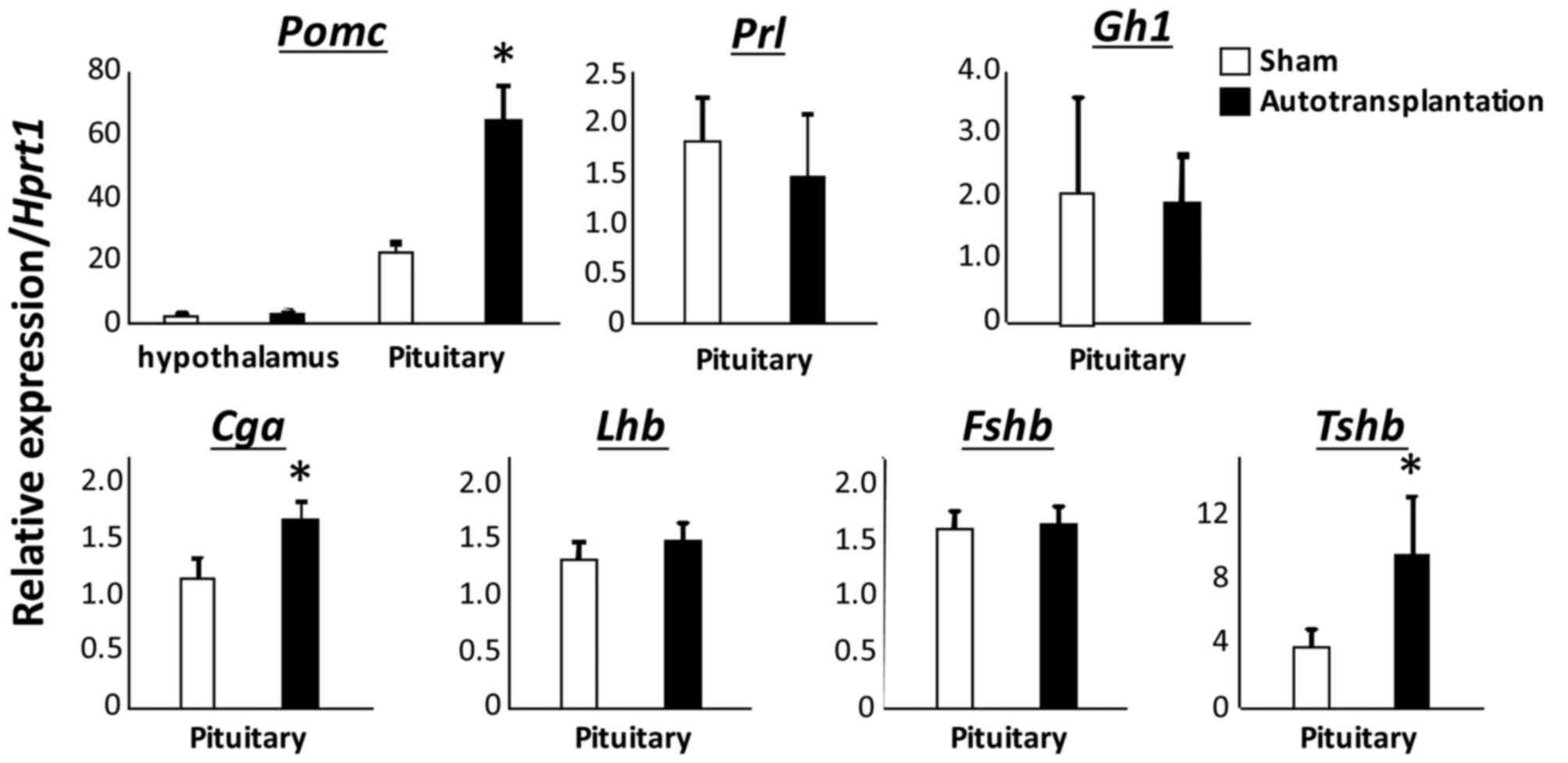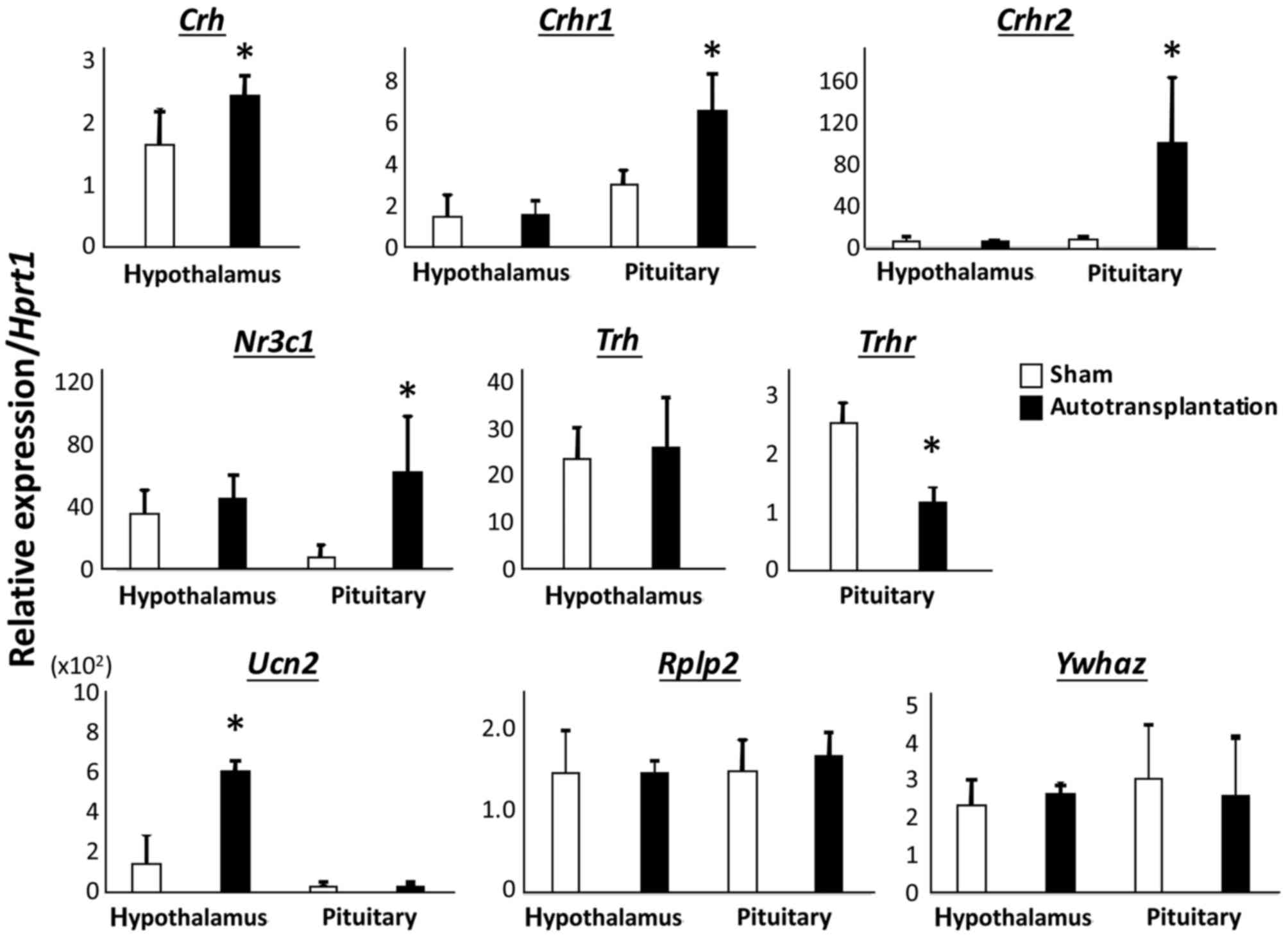|
1
|
Erdogan G, Kologlu S, Kamel N, Baskal N,
Cesur V and Eraslan S: Adrenal autotransplantation after total
adrenalectomy: Delayed determined function. Endocr J. 41:45–48.
1994. View Article : Google Scholar : PubMed/NCBI
|
|
2
|
Lucon AM, Mendonça BB, Domenice S, Chambô
JL, Wajchemberg BL and Arap S: Adrenal autografts following
bilateral adrenalectomy. J Urol. 149:977–979. 1993.PubMed/NCBI
|
|
3
|
Kubo N, Onoda N, Ishikawa T, Ogawa Y,
Takashima T, Yamashita Y, Tahara H, Inaba M and Hirakawa K:
Simultaneous bilateral laparoscopic adrenalectomy for
adrenocorticotropic hormone-independent macronodular adrenal
hyerplasia: Report of a case. Surg Today. 36:642–646. 2006.
View Article : Google Scholar : PubMed/NCBI
|
|
4
|
Inabnet WB, Caragliano P and Pertsemlidis
D: Pheochromocytoma: Inherited associations, bilaterality and
cortex preservation. Surgery. 128:1007–1012. 2000. View Article : Google Scholar : PubMed/NCBI
|
|
5
|
Okamoto T, Obara T, Ito Y, Yamashita T,
Kanbe M, Iihara M, Hirose K and Yamazaki K: Bilateral adrenalectomy
with autotransplantation of adrenocortical tissue or unilateral
adrenalectomy: Treatment options for pheochromocytomas in multiple
endocrine neoplasia type 2A. Endocr J. 43:169–175. 1996. View Article : Google Scholar : PubMed/NCBI
|
|
6
|
Taniguchi A, Tajima T, Nonomura K,
Shinohara N, Mikami A and Koyanagi T: Expression of vascular
endothelial growth factor and its receptors Flk-1 and Flt-1 during
the regeneration of autotransplanted adrenal cortex in the
adrenalectomized rat. J Urol. 171:2445–2449. 2004. View Article : Google Scholar : PubMed/NCBI
|
|
7
|
National Research Council of The National
Academies: Guide for the care and use of laboratory animals. 8th.
The National Academies Press (US); Washington, DC: 2011
|
|
8
|
Mitani F: Functional zonation of the rat
adrenal cortex: The development and maintenance. Proc Jpn Acad Ser
B Phys Biol Sci. 90:163–183. 2014. View Article : Google Scholar : PubMed/NCBI
|
|
9
|
Belloni AS, Neri G, Musajo FG, Andreis PG,
Boscaro M, D'Agostino D, Rebuffat P, Boshier DP, Gottardo G,
Mazzocchi G, et al: Investigations on the morphology and function
of adrenocortical tissue regenerated from gland capsular fragments
autotransplanted in the musculus gracilis of the rat.
Endocrinology. 126:3251–3262. 1990. View Article : Google Scholar : PubMed/NCBI
|
|
10
|
Hirose J, Masuda H, Ushiyama T, Ohtawara
Y, Ohta N, Suzuki K, Tajima A and Aso Y: Histological and
encrinological observations on the regeneration of the
autotransplanted adrenal gland in the rat. Nihon Hinyokika Gakkai
Zasshi. 79:666–672. 1988.(In Japanese). PubMed/NCBI
|
|
11
|
Srougi M and Gittes RF: Adrenal
autotransplantation. Urol Surv. 28:41–48. 1978.PubMed/NCBI
|
|
12
|
Terao A, Wisor JP, Peyron C,
Apte-Deshpande A, Wurts SW, Edgar DM and Kilduff TS: Gene
expression in the rat brain during sleep deprivation and recovery
sleep: An affymetrix genechip study. Neuroscience. 137:593–605.
2006. View Article : Google Scholar : PubMed/NCBI
|
|
13
|
Livak KJ and Schmittgen TD: Analysis of
relative gene expression data using real-time quantitative PCR and
the 2(−Delta Delta C(T)) method. Methods. 25:402–408. 2001.
View Article : Google Scholar : PubMed/NCBI
|
|
14
|
Owens MJ and Nemeroff CB: Physiology and
pharmacology of corticotropin-releasing factor. Pharmacol Rev.
43:425–473. 1991.PubMed/NCBI
|
|
15
|
Steckler T and Holsboer F:
Corticotropin-releasing hormone receptor subtypes and emotion. Biol
Psychiatry. 46:1480–1508. 1999. View Article : Google Scholar : PubMed/NCBI
|
|
16
|
Skutella T, Criswell H, Moy S, Probst JC,
Breese GR, Jirikowski GF and Holsboer F: Corticotropin-releasing
hormone (CRH) antisense oligodeoxynucleotide induces anxiolytic
effects in rat. Neuroreport. 5:2181–2185. 1994. View Article : Google Scholar : PubMed/NCBI
|
|
17
|
Skutella T, Montkowski A, Stöhr T, Probst
JC, Landgraf R, Holsboer F and Jirikowski GF:
Corticotropin-releasing hormone (CRH) antisense
oligodeoxynucleotide treatment attenuates social defeat-induced
anxiety in rats. Cell Mol Neu. 14:579–588. 1994. View Article : Google Scholar
|
|
18
|
Timpl P, Spanagel R, Sillaber I, Kresse A,
Reul JM, Stalla GK, Blanquet V, Steckler T, Holsboer F and Wurst W:
Impaired stress response and reduced anxiety in mice lacking a
functional corticotropin-releasing hormone receptor 1. Nat Genet.
19:162–166. 1998. View
Article : Google Scholar : PubMed/NCBI
|
|
19
|
Smith GW, Aubry JM, Dellu F, Contarino A,
Bilezikjian LM, Gold LH, Chen R, Marchuk Y, Hauser C, Bentley CA,
et al: Corticotropin releasing factor receptor 1-deficient mice
display decreased anxiety, impaired stress response and, aberrant
neuroendocrine development. Neuron. 20:1093–1102. 1998. View Article : Google Scholar : PubMed/NCBI
|
|
20
|
Bale TL, Contarino A, Smith GW, Chan R,
Gold LH, Sawchenko PE, Koob GF, Vale WW and Lee KF: Mice deficient
for corticotropin-releasing hormone receptor-2 display anxiety-like
behaviour and are hypersensitive to stress. Nat Genet. 24:410–414.
2000. View Article : Google Scholar : PubMed/NCBI
|
|
21
|
Coste SC, Kesterson RA, Heldwein KA,
Stevens SL, Heard AD, Hollis JH, Murray SE, Hill JK, Pantely GA,
Hohimer AR, et al: Abnormal adaptations to stress and impaired
cardiovascular function in mice lacking corticotropin-releasing
hormone receptor-2. Nat Genet. 24:403–419. 2000. View Article : Google Scholar : PubMed/NCBI
|
|
22
|
Reyes TM, Lewis K, Perrin MH, Kunitake KS,
Vaughan J, Arias CA, Hogenesch JB, Gulyas J, Rivier J, Vale WW and
Sawchenko PE: Urocortin II: A member of the corticotropin-releasing
factor (CRF) neuropeptide family that is selectively bound by type
2 CRF receptors. Proc Natl Acad Sci USA. 98:2843–2848. 2001.
View Article : Google Scholar : PubMed/NCBI
|
|
23
|
Akerblom IE, Slater EP, Beato M, Baxter JD
and Mellon PL: Negative regulation by glucocorticoids through
interference with a cAMP responsive enhancer. Science. 241:350–353.
1988. View Article : Google Scholar : PubMed/NCBI
|
|
24
|
Gurr JA and Kourides IA: Regulation of the
transfected human glycoprotein hormone alpha-subunit gene by
dexamethasone and thyroid hormone. DNA. 8:473–480. 1989. View Article : Google Scholar : PubMed/NCBI
|
|
25
|
Chatterjee VK, Madison LD, Mayo S and
Jameson JL: Repression of the human glycoprotein hormone
alpha-subunit gene by glucocorticoids: Evidence for receptor
interactions with limiting transcriptional activators. Mol
Endocrinol. 5:100–110. 1991. View Article : Google Scholar : PubMed/NCBI
|
|
26
|
Kourides IA, Weintraub BD, Re RN, Ridgway
EC and Maloof F: Thyroid hormone, oestrogen and glucocorticoid
effects on two different pituitary glycoprotein hormone alpha
subunit pools. Clin Endocrinol (Oxf). 9:535–542. 1978. View Article : Google Scholar : PubMed/NCBI
|
|
27
|
Reddy TE, Pauli F, Sprouse RO, Neff NF,
Newberry KM, Garabedian MJ and Myers RM: Genomic determination of
the glucocorticoid response reveals unexpected mechanisms of gene
regulation. Genome Res. 19:2163–2171. 2009. View Article : Google Scholar : PubMed/NCBI
|
|
28
|
Cote-Vélez A, Pérez-Martínez L, Charli JL
and Joseph-Bravo P: The PKC and ERK/MAPK pathways regulate
glucocorticoid action on TRH transcription. Neurochem Res.
33:1582–1591. 2008. View Article : Google Scholar : PubMed/NCBI
|
|
29
|
Díaz-Gallardo MY, Cote-Vélez A, Charli JL
and Joseph-Bravo P: A rapid interference between glucocorticoids
and cAMP-activated signalling in hypothalamic neurones prevents
binding of phosphorylated cAMP response element binding protein and
glucocorticoid receptor at the CRE-Like and composite GRE sites of
thyrotrophin-releasing hormone gene promoter. J Neuroendocrinol.
22:282–293. 2010. View Article : Google Scholar : PubMed/NCBI
|
|
30
|
Walter KN, Corwin EJ, Ulbrecht J, Demers
LM, Bennett JM, Whetzel CA and Klein LC: Elevated thyroid
stimulating hormone is associated with elevated cortisol in healthy
young men and women. Thyroid Res. 5:132012. View Article : Google Scholar : PubMed/NCBI
|
|
31
|
Joseph-Bravo P, Jaimes-Hoy L and Charli
JL: Regulation of TRH neurons and energy homeostasis-related
signals under stress. J Endocrinol. 224:R139–R159. 2015. View Article : Google Scholar : PubMed/NCBI
|
|
32
|
Fekete C and Lechan RM: Central regulation
of hypothalamic-pituitary-thyroid axis under physiological and
pathophysiological conditions. Endocr Rev. 35:159–194. 2014.
View Article : Google Scholar : PubMed/NCBI
|
|
33
|
Fliers E, Kalsbeek A and Boelen A: Beyond
the fixed setpoint of the hypothalamus-pituitary-thyroid axis. Eur
J Endocrinol. 171:R197–R208. 2014. View Article : Google Scholar : PubMed/NCBI
|
|
34
|
Høvring PI, Matre V, Fjeldheim AK, Loseth
OP and Gautvik KM: Transcription of the human thyrotropin-releasing
hormone receptor gene-analysis of basal promoter elements and
glucocorticoid response elements. Biochem Biophys Res Commun.
257:829–834. 1999. View Article : Google Scholar : PubMed/NCBI
|
|
35
|
Yang J and Tashjian AH Jr: Regulation of
endogenous thyrotropin-releasing hormone receptor messenger RNA in
GH4C1 cells: Roles of protein and RNA synthesis. Mol Endocrinol.
7:1144–1150. 1993. View Article : Google Scholar : PubMed/NCBI
|
|
36
|
Yang J and Tashjian AH Jr: Transcriptional
regulation by dexamethasone of endogenous thyrotropin-releasing
hormone receptor messenger ribonucleic acid in rat pituitary GH4C1
cells. Endocrinology. 133:487–490. 1993. View Article : Google Scholar : PubMed/NCBI
|












